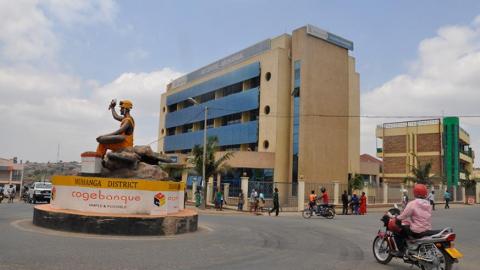
Rwanda on course to have fully operational secondary cities
At the conclusion of the 15th National Leadership Retreat earlier this year, a total of 13 resolutions were reached and recommended for immediate action through the respective implementing agencies.
Resolution seven specifically recommended for the rapid development and expansion of secondary cities.
“Support the development and expansion of secondary cities through agglomeration of economies, relocation of some Government institutions beginning with those originally located in these cities and establish their city management,” it says.
Upon adopting this resolution, the Ministry of Infrastructure (MININFRA) has indicated that they were on course to develop and expand secondary cities.
The country’s vision highlights the need to accelerate urbanisation for its transformational potential and its association with higher productivity, and higher income opportunities.
To turn this vision into reality, the country’s National Strategy for Transformation sets as one of its key objectives the transformation of Rwanda’s economic geography by facilitating urbanisation and promoting secondary cities as poles of growth namely Huye, Muhanga, Musanze, Nyagatare, Rubavu, and Rusizi districts.
These cities were chosen based on strategic location, growth trends, unique assets, and potential to become regional economic hubs. To realise their potential, these cities will require significant investments in infrastructure, socio-economic services and skills development with direct linkages to their emerging visions and strategies to attract investment and catalyse economic growth.
Rusizi City is expected to play a major role as a port city to facilitate exports.
Current state of secondary cities
Huye City, the intellectual and cultural centre of Rwanda is well-known to be an engine for the human capital development and will continue to raise skills and productivity of the national labour force.
Musanze, a home of the Volcanoes National Park and a large Pyrethrum factory will focus on ecotourism business and pyrethrum agriculture.
Rubavu, which is also a tourism destination and neighbouring Goma Town, DRC, will focus on tourism and methane gas extraction to support the national power production and facilitate export promotion.
Nyagatare can leverage on its strategic position at a major trans-border road (Northern Corridor Roads Network) to expand its trade in areas of granite tile manufacturing, livestock husbandry and milk processing.
Rusizi, which is in close proximity to Lake Kivu and to two neighbouring countries, can play a major role as a port city to facilitate export.
Muhanga, located at the crossroads of Rwanda’s major roads, will serve as a regional hub whereby products can be stored and distributed across and out of the country.
Relocation of public institutions to secondary cities
Upon recognition of the specific resolution on the relocation of public institutions to secondary cities, a team composed of MININFRA, Ministry of Public Service and Labour, Ministry of Local Government, Rwanda Housing Authority, Rwanda Governance Board and Rwanda Development Board made an assessment of the Institutions to be relocated to the 6 cities and each secondary city’s readiness to accommodate the proposed government institutions.
According to MININFRA, the team came up with a proposal of five Institutions for quick win relocation as phase 1 while other institutions to be relocated in the next phases.
During the selection process, the team considered mission and objectives of the institution in relation to the secondary city’s core business activities, branding and positioning, existing infrastructure, services and facilities located in the secondary city and nature and frequency of interaction of a given institution with other institutions located in the capital city, among others.
“To speed up implementation especially for quick-win cases, relocation of some institutions especially those that were initially located in those cities but under unjustifiable circumstances relocated to Kigali has already started. This includes specific institutions that were situated in Huye city namely academic colleges of University of Rwanda,” the Ministry says.
Process of economic agglomeration
Since 2016 the implementation of Rwanda Urban Development project (RUDP) funded by World Bank began in all six secondary cities with the main objective to provide access to basic infrastructure and enhance urban management.
The project provides support to address key challenges associated with Rwanda’s urbanisation, including access to basic infrastructure to promote liveability and local economic development, upgrading of unplanned areas to promote inclusive urbanization, building the capacity of district governments for better urban management, and supporting districts to engage with the private sector and enable local economic development.
Phase1 project implementation was completed in September 2018 with construction of 28.1 km of urban roads and 13.25km of standalone drainage. The project will, however, be implemented over 5 years (2016-2021) in two phases.
Information from the Ministry indicates that detailed engineering studies are under way for phase 2 which will focus on provision of basic infrastructure mainly urban roads, standalone drainages and upgrading informal settlements in all secondary cities and that civil works implementation will commence next financial year.
On the other hand, negotiations for another generation of Rwanda Urban Development Project (RUDP 2) are underway between the Government of Rwanda and World Bank.
There are, however, other ongoing infrastructure service projects nearing execution in partnership with different Development Partners – African Development Bank (improving water production and distribution network and improving sanitation (landfills and faecal sludge treatment plants) in four secondary cities and Enabel supporting urban socio-economic development in cities of Rubavu and Musanze including Rwamagana, another potential satellite city.
Huye City is well-known to be an engine for the human capital development and will continue to raise skills and productivity of the national labour force.
Development of industrial parks and special economic zones
For Rwanda to achieve its target of becoming a middle income country and later an upper income status, leaders believe it is inevitable that urbanisation growth goes hand in hand with industrialisation to create employment opportunities outside agriculture and increase labour productivity.
Currently, access to serviced industrial land is a major constraint for the industrial sector with the lack of designated investment zones acting as a deterrent to potential foreign investors.
In order to address this issue, the government established Kigali Special Economic Zone (KSEZ) to provide serviced land, reliable utility access and a One Stop Centre to reduce bureaucratic procedures.
KSEZ phase I and II is close to fully booked with strong investor interest remaining. Based on this success, the government thought to develop additional SEZs in strategic locations mainly in Secondary cities and other satellite cities. Recently Bugesera Industrial Park was declared as a Special Economic Zone, the second of its kind in Rwanda.
To address the above issues, industrial parks were identified in each secondary city district. In some cities like Musanze, Huye, and Rusizi, land was acquired and servicing of the industrial land with basic infrastructure is ongoing while in Muhanga, Rubavu and Nyagatare land was identified and expropriation is not yet completed.
According to the Ministry, in Nyagatare, private investments like the granite factory is operational while in Musanze, a cement factory is under construction and expected to start operations mid-2019.
Generally, industrial zones in Secondary cities if serviced with basic infrastructure and services are expected to attract more investment opportunities and create more economic opportunities and hence off-farm jobs to trigger agglomeration economies and economic competitiveness of the respective cities.
Source: The Newtimes
